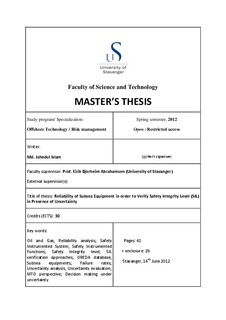| dc.description.abstract | The IEC standards 61508/61511 need to be defined and verified by the reliability targets or safety integrity targets for safety instrumented functions (SIF). The reliability targets or safety integrity targets are categorised as four safety integrity level (SIL). There are many design requirements for each SIL level, including requirements of the average probability of failure on demand (PFDavg) (Abrahamsen and W. Roed, 2010). The main objective of this master thesis was to deal with reliability of several subsea equipments in order to verify SIL level by taking uncertainty into consideration. In line with main purpose of these thesis two different approaches of SIL verification of several subsea equipments was to demonstrate according to the IEC standards 61508. The verification of the SIL requirements for the PFDavg is based on a quantitative analysis. The two approaches of SIL verification are known as the traditional approach and a new approach by Abrahamsen. The traditional approach is the approach where we can calculate PFDavg directly and then compared with the criteria for different SIL level which is shown in figure 1. However, this approach cannot be considered as an adequately good basis for decision makers to verify SIL, only by focusing on the assigned probability of failure on demand. There is a need for immense requirements of SIL verification according to the assigned probability number that can be covered through a new approach proposed by Abrahamsen. The key aspect of new approach is related to the uncertainty. There will be more discussion related to those two approaches on the later part of my thesis.
The main difference between the two approaches can easily be referred as to which way we should proceed to get a more reliable operation. It is obvious that uncertainty of any particular equipment or system can give us the different SIL requirements as compared to the traditional way of finding SIL level. Then the decision may arise from that result as to take what further improvement measure for any system in SIS of reliability assessment. A literature study of uncertainty analysis was carried out in order to identify the main sources of uncertainty in reliability assessments for several subsea equipments and also to differentiate approaches for quantifying their effects. However, the broadly accepted standard for design and operation of SIS, IEC 61508, does not explicitly treat the subject of uncertainty. Therefore, my focus is to contemplate clear concepts on uncertainty factors before going to make decisions on SIL level verification. I have done several calculations of PFDavg for various subsea equipments by considering different times of operation. I was highly fascinated to see the widely varying probability numbers from those calculations. And thus, I started to analyze why the failure rates are higher for some particular subsea equipments, which will be discussed in the later part of my thesis. Generally those failure rates comes from the uncertainties of those equipments which are causes of several factors such human involvement workplace, human error, hardware problem, software problem, lack of reliable data collection, poor management systems, typical work process between experienced and inexperienced personnel, inexperience personnel working on the new technologies etc. It was found that sensitivity analysis could also be an important measure to categorize uncertainties. There was important discussion about the human factors in process industries and several uncertainty evaluations according to the MTO (Human, Technology and Organization) perspectives. | no_NO |
